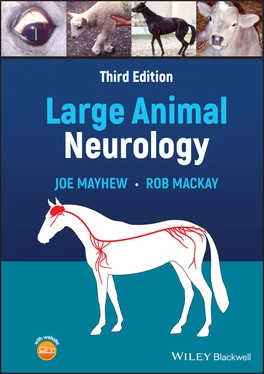As with other cranial nerves, a diagnosis of CNS disease, compared to peripheral nerve involvement, can be made by identifying involvement of adjacent structures in the medulla oblongata when signs such as lethargy, limb weakness and ataxia, and a head tilt will often result. With lesions of the inner ear, which cause vestibular signs, there is often accompanying facial nerve paralysis because of concurrent middle ear involvement, and the facial nerve is only separated from the tympanic cavity by a thin membrane. Lack of any involvement of other central pathways is used to differentiate signs of such peripheral facial and vestibular nerve disease from involvement of their nuclei and their pathways in the medulla oblongata. Exquisitely focal lesions resulting from agents such as Sarcosystis neurona and Listeria monocytogenes can exceptionally destroy single and multiple central nuclear regions causing signs of selective cranial nerve dysfunction without producing clinical evidence of adjacent brainstem involvement, thereby mimicking peripheral cranial nerve disease.
Of some note here is involvement of the parasympathetic greater petrosal branch of the facial nerve innervating the lacrimal gland. Lesions affecting this component of the facial nerve anywhere from the medulla oblongata to the back of the eye often result in a dry eye. Subsequent development of keratoconjunctivitis sicca can mean the loss of an eye, making early detection of such a sign most important.
With various thalamic and cerebral lesions in horses, the facial muscles may be hypertonic and facial reflexes may be hyperactive, resulting in spontaneous and reflexive grimacing of the face. This is due to the involvement of the central motor pathway controlling facial movement that normally influences the facial nucleus and facial reflexes. Importantly, even in the presence of poor facial expression and control, the facial reflexes are still intact and may be hyperactive. Irritative lesions, such as viral encephalitis, meningitis, and facial neuritis, can also cause spontaneous and reflexly induced facial grimacing.
Vestibulocochlear nerve—CN VIII
The cochlear or auditory division of this nerve transmits impulses involved with hearing. Bilateral middle ear disease causes deafness, but unilateral hearing loss would be difficult or impossible to detect clinically in large animals without the use of auditory evoked potential recordings.
The vestibular division of CN VIII supplies the major input to the vestibular system ( Figure 2.11), thereby controlling balance. Fibers from the inner ear pass through the internal acoustic meatus in the petrosal bone and penetrate the lateral medulla oblongata to terminate in the vestibular nuclei. A few fibers pass to small areas in the ventral cerebellum that are part of the vestibular system. The vestibular system receives input from the inner ear and functions by controlling orientation of the head, body, limbs, and eyes in space and with respect to gravity. Signs of vestibular disease can be seen with lesions involving any part of the vestibular system. The eyeballs are checked for normal vestibular nystagmus when the head is moved from side to side. The presence of spontaneous nystagmus seen with the head in a normal position, and positional nystagmus seen with the head held still in various abnormal positions, indicate a disorder of the vestibular system. In unilateral peripheral vestibular system disorders, the fast phase of any nystagmus is quite consistently directed away from the side of the lesion and away from the direction of the head tilt. It is usually horizontal, although it may be rotary or arc‐shaped. Only in a few horses with peracute signs of bilateral vestibular neuritis, histologically consistent with polyneuritis equi, transient, dorsally directed nystagmus has been observed with a peripheral—in this case bilateral—vestibular disorder. With lesions involving the central components of the vestibular system in the medulla oblongata, spontaneous and positional nystagmus may be horizontal, vertical or rotary, and may change direction with changes in head posture. Such lesions frequently affect adjacent structures, such as the proprioceptive and motor pathways for voluntary limb movement, and the reticular formation, resulting in ataxia and tetraparesis, and somnolence, respectively. Particularly with acute peripheral vestibular disease, signs often improve within several days because of accommodation, mediated by other inputs to the vestibular system including proprioceptive modalities and especially vision. By blindfolding a patient that has accommodated to its vestibular disease, signs frequently become exacerbated immediately. Additionally, blindness interferes with recovery from vestibular disease.

Figure 2.11 Vestibular system.
On rare occasions, central unilateral or asymmetric CNS lesions, particularly if in the region of the caudal cerebellar peduncle, may result in paradoxical vestibular signs. This is seen as any head tilt and circling being away from, and the fast phase of nystagmus being toward, the side of the lesion. Defining the side of such a lesion will depend on identifying other signs of cerebellar and/or medullary disease.
A rather forgotten component to the vestibular system is proprioceptive input from the cranial cervical vertebrae, ligaments, and muscles. 23,24From this region, afferent fibers pass via at least the C 1–3dorsal spinal nerve roots to ascend the spinal cord to the caudal part of the medial vestibular nuclei that receive no other afferent inputs ( Figure 2.11). 25Like damage to the vestibular nerve, lesions involving these cervical nerves or the cervical spinal input to the vestibular apparatus can result in signs of vestibular disease. This certainly can be seen with asymmetric lesions of the dorsal nerve roots of C 1–3when loss of balance, eye deviation, and a head tilt can be seen.
Glossopharyngeal nerve—CN IX; vagus nerve—CN X; accessory nerve—CN XI
A major function of these cranial nerves is achieved through innervation of the pharynx and larynx with both sensory and motor fibers. This is tested by listening for normal laryngeal sounds, observing normal swallowing of food and water, assessing the swallowing reflex by passage of an esophageal tube, and finally by inspection of the larynx and pharynx manually and preferably with the aid of an endoscope. The major centers for control of the pharynx and larynx via these three cranial nerves are the nucleus ambiguus and nucleus solitarius in the caudal medulla oblongata. The most important clinical signs of dysfunction are related to paralysis of the pharynx and larynx, and the severity of signs depends on whether there is unilateral or bilateral involvement. In pharyngeal paralysis, usually food, water, and saliva can be seen at the nostrils in horses, and at the nostrils and mouth in ruminants, and spilling onto the floor. During exercise, unilateral paralysis of the larynx results in an abnormal respiratory noise—so‐called roaring in physically active horses, but is usually subclinical in sedentary animals. Stertorous breathing may be detected with diseases that cause bilateral pharyngeal or laryngeal paralysis.
In the horse at least, the thoraco‐laryngeal adductor response, or slap test ( Figure 2.12), should be performed. 26The skin just caudal to the dorsal aspect of the scapula is slapped firmly with a hand while the horse is exhaling, and while the larynx is observed with an endoscope, the normal response being brief adduction of the contralateral arytenoid cartilage. Contraction of the contralateral dorsal and lateral laryngeal musculature over the muscular process of the arytenoid cartilage can also be palpated with the fingers while the withers are slapped. This has been detected in cooperative foals as early as 2 weeks of age. Usually, this response can be felt externally as a slight tap or muscular contractions under the fingers. The afferent pathway is through the segmental dorsal thoracic nerves to the spinal cord, cranially in the contralateral cervical spinal cord white matter, and thus to the contralateral vagal motor nucleus in the medulla oblongata. From there, the efferent pathway is through the contralateral vagus nerve to the cranial thorax and then back up the neck in the recurrent laryngeal nerve to the larynx. The reflex can be interrupted at any of these sites.
Читать дальше













